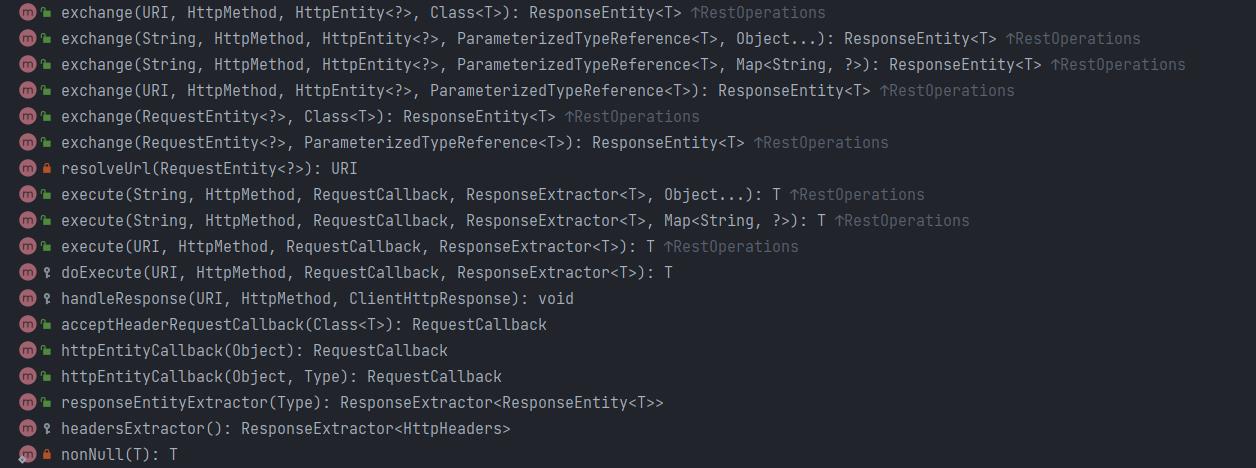RestTemplate发送请求
Posted 倾锋落颖花
tags:
篇首语:本文由小常识网(cha138.com)小编为大家整理,主要介绍了RestTemplate发送请求相关的知识,希望对你有一定的参考价值。
RestTemplate
简介
RestTemplate是由Spring框架提供的一个可用于应用中调用rest服务的类它简化了与http服务的通信方式,统一了RESTFul的标准,封装了http连接,我们只需要传入url及其返回值类型即可。相较于之前常用的HttpClient,RestTemplate是一种更为优雅的调用RESTFul服务的方式。- 在
Spring应用程序中访问第三方REST服务与使用Spring RestTemplate类有关。RestTemplate类的设计原则与许多其他Spring的模板类(例如JdbcTemplate)相同,为执行复杂任务提供了一种具有默认行为的简化方法。 RestTemplate默认依赖JDK提供了http连接的能力(HttpURLConnection),如果有需要的话也可以通过setRequestFactory方法替换为例如Apache HttpCompoent、Netty或OKHttp等其他Http libaray。- 考虑到了
RestTemplate类是为了调用REST服务而设计的,因此它的主要方法与REST的基础紧密相连就不足为奇了,后者时HTTP协议的方法:HEAD、GET、POST、PUT、DELETE、OPTIONS例如,RestTemplate类具有headForHeaders()、getForObject()、putForObject(),put()和delete()等方法。
创建RestTemplate
因为RestTemplate是Spirng框架提供的所以只要是一个Springboot项目就不用考虑导包的问题,这些都是提供好的。
但是Spring并没有将其加入SpringBean容器中,需要我们手动加入,因为我们首先创建一个Springboot配置类,再在配置类中将我们的RestTemlate注册到Bean容器中
方法一
使用Springboot提供的RestTemplateBuilder构造类来构造一个RestTemplate,可以自定义一些连接参数,如:连接超时时间,读取超时时间,还有认证信息等
[外链图片转存失败,源站可能有防盗链机制,建议将图片保存下来直接上传(img-gESc8its-1671163170915)(null)]
@Configuration
public class WebConfiguration
@Bean
public RestTemplate restTemplate(RestTemplateBuilder builder)
return builder
//设置连接超时时间
.setConnectTimeout(Duration.ofSeconds(5000))
//设置读取超时时间
.setReadTimeout(Duration.ofSeconds(5000))
//设置认证信息
.basicAuthentication("username","password")
//设置根路径
.rootUri("https://api.test.com/")
//构建
.build();
添加自定义的拦截器
自定义拦截器示例
@Slf4j
public class CustomClientHttpRequestInterceptor implements ClientHttpRequestInterceptor
@Override
public ClientHttpResponse intercept(HttpRequest request, byte[] body, ClientHttpRequestExecution execution) throws IOException
//打印请求明细
logRequestDetails(request,body);
ClientHttpResponse response = execution.execute(request, body);
//打印响应明细
logResponseDetails(response);
return response;
private void logRequestDetails(HttpRequest request, byte[] body)
log.debug("Headers:",request.getHeaders());
log.debug("body:",new String(body, StandardCharsets.UTF_8));
log.debug(":",request.getMethod(),request.getMethodValue());
private void logResponseDetails(ClientHttpResponse response) throws IOException
log.debug("Status code : ",response.getStatusCode());
log.debug("Status text : ",response.getStatusText());
log.debug("Headers : ",response.getHeaders());
log.debug("Response body: ", StreamUtils.copyToString(response.getBody(),StandardCharsets.UTF_8));
使用RestTemplateBuilder构造类,添加自定义拦截器,构造带有自定义拦截器的RestTemplate实例
@Configuration
public class WebConfiguration
@Bean
public RestTemplate restTemplate(RestTemplateBuilder builder)
return builder
.additionalInterceptors(new CustomClientHttpRequestInterceptor())
//构建
.build();
测试请求确实经过了拦截器,注册成功(注意请求和响应的流只会被读取一次,这里我们读取了response后返回的response就读取不到刚刚读过的内容了)
[外链图片转存失败,源站可能有防盗链机制,建议将图片保存下来直接上传(img-bGymqlEL-1671163170885)(null)]
方法二
使用RestTemplate构造方法构造一个RestTemlate,虽然不能像RestTemplate构造类那样更详细、更多样的配置参数,但是RestTemplate构造方法在一般情况是够用的。

- 无参构造 全部参数默认
- 指定
ClientHttpRequestFactory的构造方法可以指定自己实现的ClientHttpRequestFactory(客户端http请求工厂)其他的与无参构造相同。ClientHttpRequestFactory
- 指定
List<HttpMessageConverter<?>>的构造方法可以指定自己是实现的HttpMessageConverter(Http消息转换器)传入其他与无参构造相同。
@Configuration
public class WebConfiguration
@Bean
public RestTemplate restTemplate()
return new RestTemplate();
两者方法都可使用,前者提供了多样的自定义参数的选择,可以将RestTemplate配置的更为完善,后者则简化了配置虽然配置多样性不如前者,但是日常使用调用些API还是足以使用
RestTemplate API使用
在使用RestTemplate前先让我们看看RestTemplate有哪些API


相信大家看到这么多方法,一定很头大,但是我们仔细看上述的方法,我们可以提取出主要的几种方法是(这里只讨论Http请求的):
GETPOSTPUTDELETEHEADOPTIONSEXCHANGEEXECUTE
**这里我给大家安利一个一个网站,它提供免费的RESTFul api的样例测试。httpbin A simple HTTP Request & Response Service.
GET
通过上图我们可以发现RestTemlate发送GET请求的方法有两种
public <T> T getForObject(...)public <T> ResponseEntity<T> getForEntity(...)
getForEntity()
后缀带有Entity的方法都代表返回一个ResponseEntity<T>,ResponseEntity<T>是Spring对HTTP请求响应的封装,包括了几个重要的元素,如响应码,contentType、contentLength、响应消息体等

通过它继承父类(HttpEntity<T>)的getHeader()方法我们可以获取contentType、contentLength、响应消息体等。比如下面这个例子。
public void queryWeather()
ResponseEntity<Object> forEntity = restTemplate.getForEntity("https://restapi.amap.com/v3/weather/weatherInfo?city=510100&key=e7a5fa943f706602033b6b329c49fbc6", Object.class);
System.out.println("状态码:"+forEntity.getStatusCode());
System.out.println("状态码内容:"+forEntity.getStatusCodeValue());
HttpHeaders headers = forEntity.getHeaders();
System.out.println("响应头:"+headers);
Object body = forEntity.getBody();
System.out.println("响应内容:"+body);
该例子中getForEntity()方法的第一个参数为我要调用服务的URL,第二个参数则为响应内容的类的类型(Java嘛 万物皆对象)还可以添加第三个参数,第三个参数为一个可变参数 代表着调用服务时的传参。
[外链图片转存失败,源站可能有防盗链机制,建议将图片保存下来直接上传(img-Oz8lczhw-1671163170864)(null)]
第三个参数可以使用key-value的map来传入参数
get请求也可通过向在url上添加查询参数来发送带有请求的参数
getForObject()
相比于前者getForEntity()该方法则是,更偏向于直接获取响应内容的,因为他直接返回响应实体的body(响应内容),。比如下面这个例子
public void queryWeather()
Object body = restTemplate.getForObject("https://restapi.amap.com/v3/weather/weatherInfo?city=510100&key=e7a5fa943f706602033b6b329c49fbc6", Object.class);
System.out.println(body);
方法参数签名与getForEntity()基本一致。
当你只需要返回的响应内容时,使用getForObject()是一个很好的选择,但当你需要获得更详细的响应信息,如响应头中的信息,你就只能选择getForEntity()了。
POST
POST请求有如下三种方法
public URI postForLocation(...)public <T> T postForObject(...)public <T> ResponseEntity<T> postForEntity(...)
后两种用法与GET基本一致不做详细介绍,这里着重介绍postForLocation()
postForEntity()
该方法有三个参数,第一个为调用服务的地址(URL)
第二个参数表示上传的参数(json格式提交)
第三个表示返回响应内容的具体类型
第四个参数也用于指定参数(在URL中添加)
@Override
public void queryWeather()
User user = new User();
user.setName("鲁大师");
ResponseEntity<Object> objectResponseEntity = restTemplate.postForEntity("https://restapi.amap.com/v3/weather/weatherInfo?city=510100&key=e7a5fa943f706602033b6b329c49fbc6", user, Object.class);
System.out.println("消息响应内容:"+objectResponseEntity.getBody());
postForObject()
使用方法与getForObject类似只是多了一个传入对象参数(传入方式与postForEntity()相同)
public void queryWeather()
User user = new User();
user.setName("鲁大师");
ResponseEntity<Object> objectResponseEntity = restTemplate.postForEntity("https://httpbin.org/post", user, Object.class);
MediaType contentType = objectResponseEntity.getHeaders().getContentType();
System.out.println(contentType);
System.out.println("消息响应内容:"+objectResponseEntity.getBody());
postForLocation()
postForLocation传参用法与前两者一致,只不过返回从实体变成了一个URL,因此它不需要指定返回响应内容的类型。
public void queryWeather()
User user = new User();
user.setName("鲁大师");
URI uri = restTemplate.postForLocation("https://httpbin.org/post", user);
System.out.println(uri);
这个只需要服务提供者返回一个 URI 即可,该URI返回值体现的是:用于提交完成数据之后的页面跳转,或数据提交完成之后的下一步数据操作URI。
使用POST以表单方式提交
这里我们着重说一下,如何自己封装一个请求体。
我们需要用到如下几个类
HttpHeadersMultiValueMap<K,V>HttpEntity<T>
HttpHeaders
故名思意,就是用来封装Http请求的请求头的,这里我们要设置他的ContentType为**MediaType.APPLICATION_FORM_URLENCODED**以使得我们提交的参数是以Form(表单)的形式提交。
//设置请求头, x-www-form-urlencoded格式的数据
HttpHeaders httpHeaders = new HttpHeaders();
//这里指定参数以UTF-8编码格式传输
MediaType mediaType = new MediaType(MediaType.APPLICATION_FORM_URLENCODED, UTF_8);
httpHeaders.setContentType(mediaType);
//提交参数设置
MultiValueMap<String, String> map = new LinkedMultiValueMap<>();
map.add("name","鲁大师");
MultiValueMap<K,V>
该类是用来封装请求参数的,是以key-value的形式封装但是以单个key对应多个value的格式传输(也就是是以单个key:[value...]的格式传输的)。
//提交参数设置
MultiValueMap<String, String> map = new LinkedMultiValueMap<>();
map.add("name","鲁大师");
如果像传输单个key对应单个value使用普通的Map传参即可
HttpEntity<T>
该类是用来封装请求的,主要作用就是将请求头和请求体封装在一起成为一个请求实体 T用来指定用来封装参数的容器的类型。
//组装请求体
HttpEntity<MultiValueMap<String, String>> request = new HttpEntity<>(map, httpHeaders);
测试
通过上述介绍后,我们就可以自己封装一个以form形式提交参数的POST请求了。
@Test
void contextLoads()
//请求地址
String url = "https://httpbin.org/post";
//设置请求头, x-www-form-urlencoded格式的数据
HttpHeaders httpHeaders = new HttpHeaders();
httpHeaders.setContentType(MediaType.APPLICATION_FORM_URLENCODED);
//提交参数设置
MultiValueMap<String, String> map = new LinkedMultiValueMap<>();
map.add("name","鲁大师");
//组装请求体
HttpEntity<MultiValueMap<String, String>> request = new HttpEntity<>(map, httpHeaders);
//发送post请求并打印结果 以String类型接收响应结果JSON字符串
String s = restTemplate.postForObject(url, request, String.class);
System.out.println(s);

通过拦截器拦截了请求并对请求头进行拆包,可以发现ContentType已经被修改成了x-www-form-urlencoded格式了。
PUT
PUT请求的方法只有一类
void put()
PUT()
使用方法与postForEntity()参数基本一致,只是put方法没有返回值(也就不必去设置响应内容的类型了)。
@Test
void contextLoads()
//请求地址
String url = "http://httpbin.org/put";
User user = new User();
user.setName("鲁大师");
restTemplate.put(url,user);
DELETE
与PUT一样,DELETE方法只有一类
void delete()
delete()
delete()可以指定url中的中的参数,但是RestTemplate的delete()方法是不支持上传requestBody的。
void contextLoads()
//请求地址
String url = "http://httpbin.org/delete";
restTemplate.delete(url);
HEADER
HEADER也只有一类方法
public HttpHeaders headForHeaders()
主要用来发送请求获取响应头部信息,但是像DELETE、PUT这类没有响应的方法,是不能使用该方法的(因为没有响应也就没有响应头了)。
@Test
void contextLoads()
//请求地址
String url = "http://httpbin.org/get";
HttpHeaders httpHeaders = restTemplate.headForHeaders(url);
System.out.println(httpHeaders);

OPTIONS
public Set<HttpMethod> optionsForAllow()
该方法的主要用来判断该服务地址,能够使用那种方法去执行
@Test
void contextLoads()
//请求地址
String url = "http://httpbin.org/get";
Set<HttpMethod> httpMethods = restTemplate.optionsForAllow(url);
System.out.println(httpMethods);

EXCHANGE
<T> ResponseEntity<T> exchange()
该接口与其他接口不同
- 该方法允许用户指定请求的方法(
get,post,put等)- 可以在请求中增加body以及头信息,其内容通过参数
HttpEntity<?> requestEntity描述exchange支持’含参数的类型(即泛型)'作为返回类型,该特性通过ParameterizedTypeReferenceresponseType描述
该方法支持五个参数
- 第一个是服务地址
- 第二个是请求方法
- 第三个是写入的请求实体
- 第四个是响应内容的类型
- 第五个是扩展模板的变量或包含
URI模板变量的映射
@Test
void contextLoads()
//请求地址
String url = "http://httpbin.org/post";
User user = new User();
user.setName("彭于晏");
HttpHeaders httpHeaders = new HttpHeaders();
httpHeaders.setContentType(MediaType.APPLICATION_JSON);
HttpEntity<User> userHttpEntity = new HttpEntity<>(user, httpHeaders);
ResponseEntity<Object> exchange = restTemplate.exchange(url, HttpMethod.POST, userHttpEntity, Object.class);
System.out.println(exchange);
上述代码模拟了一个简单的POST请求 可以理解为可以动态的指定请求方法和请求实体的一个方法。
响应实体
[外链图片转存失败,源站可能有防盗链机制,建议将图片保存下来直接上传(img-RhHTigxt-1671163170900)(null)]
EXECUTE
<T> T execute()
该方法就是执行请求的方法,我们可以发现上述的所有方法的最后执行都是调用的该方法执行,所以他在RestTemplate中十分重要
该方法有五个参数
- 服务地址
- 请求的方法
- 准备请求的对象(
requestCallback)- 从响应中提取返回值的对象
- 扩展模板的变量或包含
URI模板变量的映射
execute()
@Override
@Nullable
public <T> T execute(String url, HttpMethod method, @Nullable RequestCallback requestCallback,
@Nullable ResponseExtractor<T> responseExtractor, Object... uriVariables) throws RestClientException
URI expanded = getUriTemplateHandler().expand(url, uriVariables);
return doExecute(expanded, method, requestCallback, responseExtractor);
通过上述源码我们可以发现execute()方法只是将我们传入的String类型的URL转换为了URL类型,最后执行请求是由doExecute()方法
doExecute()
这里需要了解两个类:RequestCallback和ResPonseExtractor
RequestCallback: 用于操作请求头和body,在请求发出前执行。不需要关心关闭请求或处理错误:这都将由RestTemplate处理。
该接口有两个实现类:
[外链图片转存失败,源站可能有防盗链机制,建议将图片保存下来直接上传(img-sfZnB4fi-1671163170935)(null)]
ResPonseExtractor: 解析HTTP响应的数据,而且不需要担心异常和资源的关闭。
该接口在RestTemplate中同样有两个实现类:
HeadersExtractor | 提取响应HttpHeaders的响应提取器。直接提取响应体中的响应头 | |
|---|---|---|
ResponseEntityResponseExtractor<T> | HttpEntity的响应提取器。可以获取响应实体里面包括响应头,响应体等。具体请查看HttpEntity |
@Test
void contextLoads()
//请求地址
String url = "http://httpbin.org/post";
User user = new User();
user.setName("彭于晏");
HttpHeaders httpHeaders = new HttpHeaders();
httpHeaders.setContentType(MediaType.APPLICATION_JSON);
HttpEntity<User> userHttpEntity = new HttpEntity<>(user, httpHeaders);
ResponseEntity<Object> execute = restTemplate.execute(url, HttpMethod.POST, restTemplate.httpEntityCallback(userHttpEntity), restTemplate.responseEntityExtractor以上是关于RestTemplate发送请求的主要内容,如果未能解决你的问题,请参考以下文章